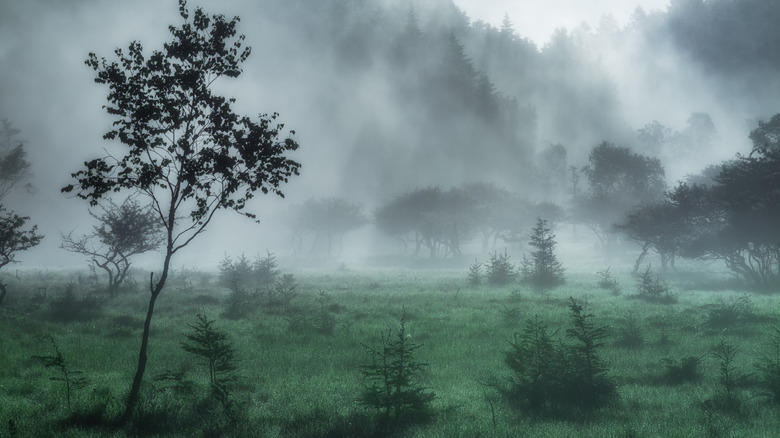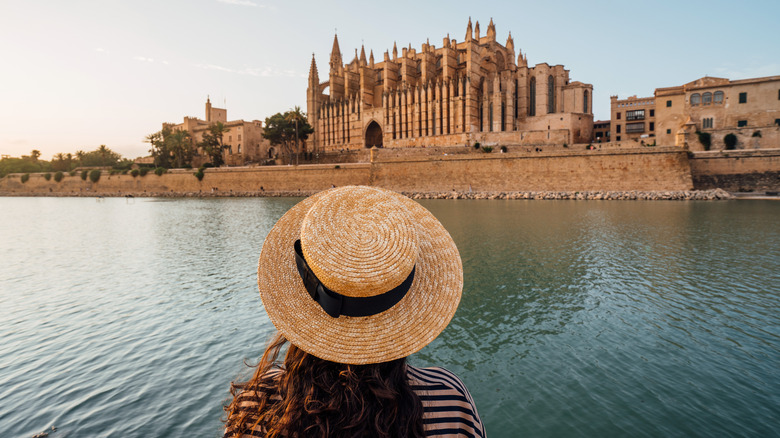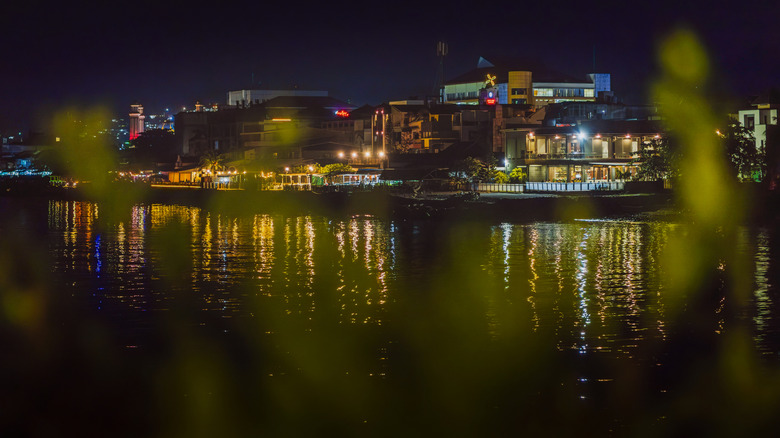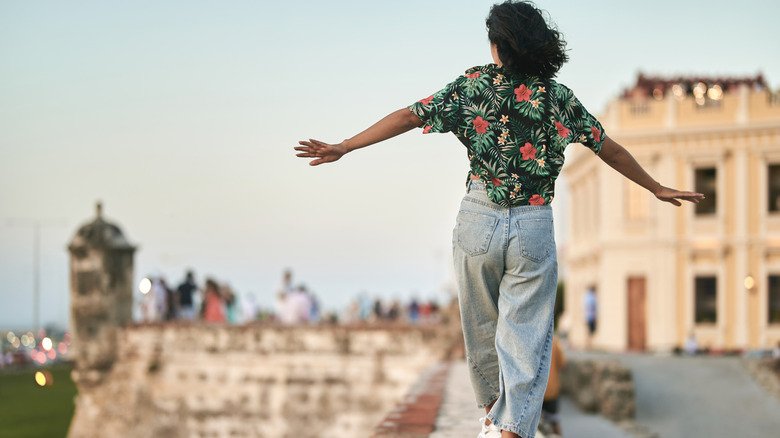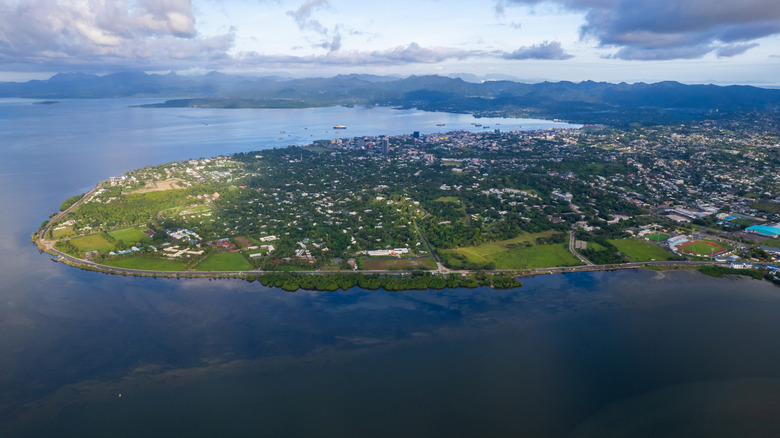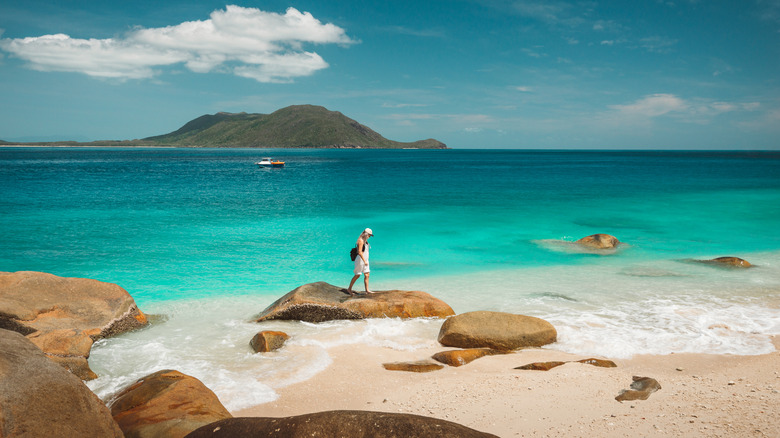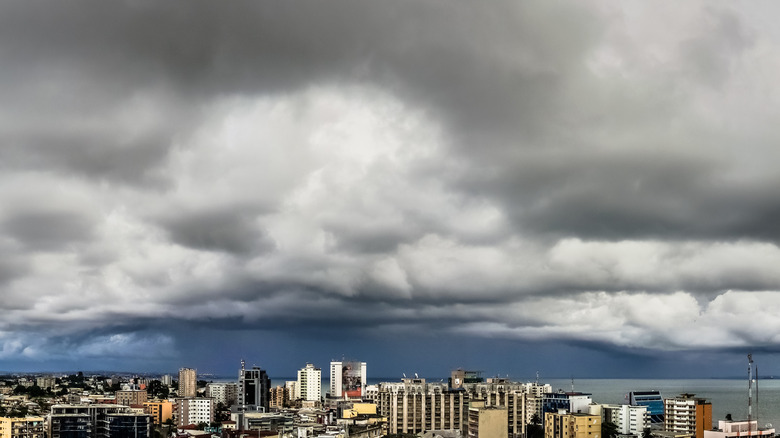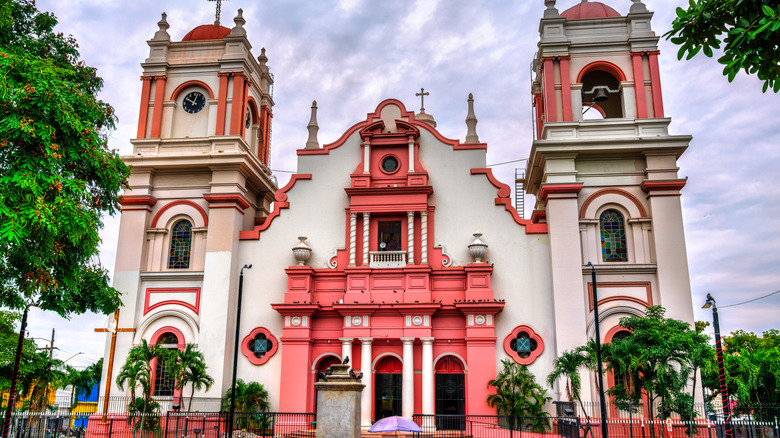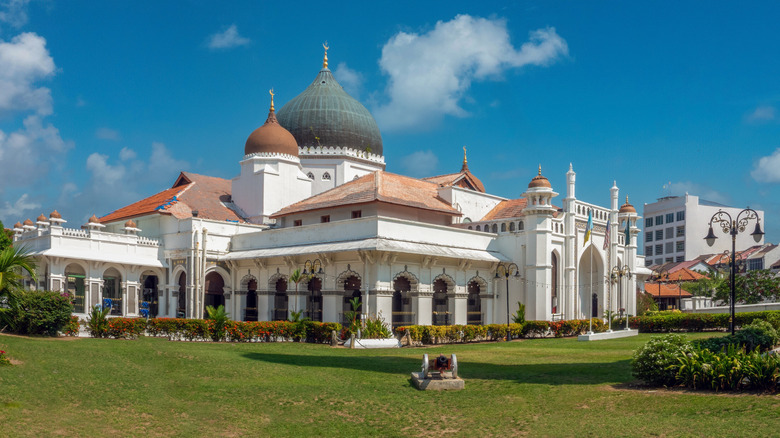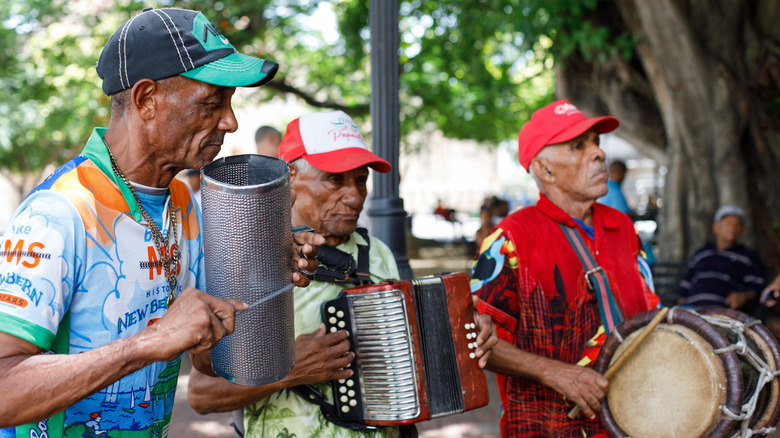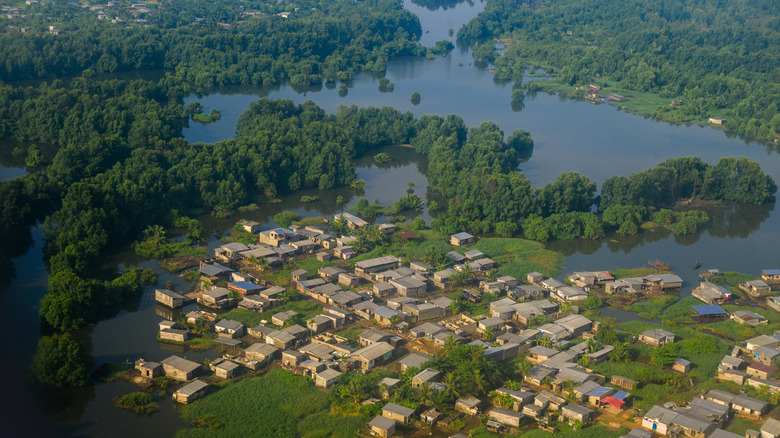Cities With The Highest Humidity Levels In The Whole World
It's not the heat that gets you; it's the humidity. A visceral concept, Homo Sapiens must have endured the complications of atmospheric moisture since their very earliest days. However, it is purported that the Chinese were the first to study the phenomenon. In the third century CE, they constructed a simple tool of clay and charcoal to determine whether the air was wet or dry. In 1480, Leonardo da Vinci built the world's first Hygrometer, a device used to measure the amount of water vapor in the air. Down the line, Sir John Leslie invented a wet-dry bulb sensor in the 19th century, and improvements in design continued apace.
The discomfort associated with high humidity stems from two factors. Firstly, it enjoys warmer climes — air at 95 degrees Fahrenheit can hold 6 times more water vapor than air at 41 degrees Fahrenheit. Second, it inhibits one of the body's principal ways of keeping cool via sweat glands. In times of high humidity, sweat cannot evaporate. Instead, it clings to your body and clothes, bringing with it the telltale uncomfortable stickiness of a hot, wet day. Meanwhile, the so-called dew point is reached when the air becomes so drenched with moisture that it simply cannot contain anymore. And, of course, the closer you get to maximum saturation, the more humid it feels.
This is not to say that nations and cities that experience high humidity should be avoided. Choosing the right time to travel there is often critical. Sure, there are some places you should never visit in summer, but everywhere has a down-season. Just double-check that your hotel room is air-conditioned.
Palma, Spain
It may surprise some people that Europe does not feature heavily in this list. To be sure, there are some extraordinarily hot and humid places in Europe. Valencia — one of the most charming and budget-friendly European destinations – boasts 116.8 days of uncomfortable humidity. Other locations, almost all of which are situated in either Spain or Italy, lag not far behind.
Still, although nowhere in Europe can compete with the levels of humidity found in cities clustered around the tropics, the stunning coastal town of Palma manages to take the European crown. The capital city of Mallorca, Palma, has long been known for its stunning beaches, gastronomic delights, and bouncing nightlife. It receives 300 days of sunshine a year, and humidity levels become uncomfortable around one-third of the time. While what exactly constitutes discomfort might vary from person to person, the accepted definition is that anything with a humidity level of above 60% or below 30% is most assuredly less than ideal.
People flock there regardless. In 2023, Mallorca welcomed over 12 million visitors to its island paradise, with the highest number arriving in July, one of the hottest and most humid times of the year. A place of beaches and swimming pools, opportunities to cool off abound, and for those who take advantage of such amenities, the wet heat is more than manageable.
Balikpapan, Indonesia
About halfway down the east coast of Borneo, some 5 miles north of the stunning Kemala beach, lies Balikpapan, a vibrant, lived-in city of 680,000, much frequented by visitors from all over the island and beyond. Known for its bustling market of precious stones, stunning Masjid Agung At-Taqwa, and the golden sands of Kemala Beach, Balikpapan ticks all the boxes when it comes to planning a getaway. With one somewhat predictable catch — said getaway is liable to be a steamy one.
Uncomfortable levels of humidity occur on no fewer than 365 days a year, a number that far outshines anything Europe can muster. And that's not the worst of it. For a full 268.8 days of the year, the humidity reaches extreme levels. Such a metric — defined as a temperature of 75 degrees Fahrenheit or above, working in concert with the dew point maximum — is something you'll feel deep down inside. Still, the sea temperature is pleasant all year round, though December to April is marred by often excessive rains. Thankfully, between June and October, things tend to ease off a little. During such times, those looking for ideal destinations for eco-conscious adventures will find that the lush rainforests of Borneo can be explored with relative comfort. For everyone else, the beaches beckon.
Cartagena, Colombia
In recent years, the number of South American cities that have been capturing the internet with their solo-friendly travel potential seems to have increased exponentially. Cartagena finds itself somewhere near the top of that list for several reasons. Its proximity is certainly one of them. As the crow flies, Cartagena is just a shade under a three-hour flight from Miami, making it one of the closest South American destinations to the USA.
Upon arrival, visitors are treated to a thriving coastal city that positively drips with old-world charm. Founded in 1533, Cartagena de Indias — to give it its full title — was an important cog in Spain's near-mechanized desire to extract every ounce of silver from the Americas as humanly possible. It was also quite naturally (for the time) a major slave market.
Today, it is better known for the remnants of its colorful past. Tourists flock to the Castillo San Felipe de Barajas, a 17th-century fortress overlooking the city with a long-held reputation for being impregnable. A walk around the town's ancient walls is a must for those interested in excellent views of the city's colorful, colonial architecture. In addition, the beaches fringing its Caribbean coastline are exactly as you'd expect them to be: golden, pristine, and glorious.
The city experiences year-round uncomfortable humidity, with 248.9 days considered extreme. Still, although a dip in the ocean tends to take care of the worst excesses of the day, a recent travel advisory warning from the U.S. government is of more concern. As always, travelers should check before planning a trip.
Suva, Fiji
When people turn their minds to Fiji, they naturally conjure up images of white sandy beaches, immaculate coral reefs, aquamarine waters, and a rich cultural heritage. The incredible humidity they might face during a visit springs to mind a little less often. Fiji is an archipelago in the South Pacific, approximately five hours by air north of Auckland, New Zealand, and consists of around 300 islands. Its capital city, Suva, is located on the larger of the two main islands. It is a place packed to the brim with parks, grandiose colonial architecture, local markets, and radiant nightlife.
The city is perfect for cycling and is, as you'd expect, something of a surfer's paradise. Heat, however, can be a problem. The average temperature rarely drops below 70 degrees Fahrenheit year-round, and typical highs tend to hover around the mid-80s (degrees Fahrenheit). This, when coupled with 356.6 days of uncomfortable levels of humidity, helps to explain why water-related activities rank so high here.
Cairns, Australia
As with Fiji, most of us have a mental picture of what Australia is like. There are the deep harbors, dangerous wildlife you want to avoid, unparalleled surf, and thrilling cities. We think of the Opera house, the Great Barrier Reef, the kangaroos, and, if we must, the national obsession with Vegemite. Rarely do minds turn to its tropical north, which is a shame, really.
Off the top of heads, lists of Australian cities tend to begin and end with Sydney. More enlightened travelers will include Melbourne, Adelaide, or Brisbane; some might even remember that the capital is, in fact, Canberra. Fewer still recall Cairns. Situated on the upper portion of Australia's East Coast, some 24 miles west of the Trinity Reserve Forest, this tropical enclave of a little over 150,000 residents hits well above its weight.
Exploring ancient tropical forests by cable car, diving at the Great Barrier Reef, or simply spending time schmoozing around restaurants and bars are all on offer. The city rewards exploration even as it encourages a slower pace of life. Indeed, building a bespoke Australian adventure by taking the Great Ocean Road is an experience in itself. Temperature-wise, things are a little sticky. The city enjoys 315 days of difficult-to-endure humidity, and while things skew a little cooler during the winter, which lasts from June to August, you can still expect highs of 78 degrees Fahrenheit.
Libreville, Gabon
Gabon is an oil-rich, rainforest-strewn country in central Africa blessed with a broad stretch of fine Atlantic coast. French-speaking – a throwback to its colonial heritage – the capital city, Libreville, sits just 13 miles south of the sprawling Akanda National Park. Political instability has undermined attempts to stimulate the country's tourism industry, which remains anemic to this day. It's not for want of things to see and do. The capital sports some fantastic places to relax, such as La Pointe Denis beach and Casino Croisette. It also benefits from proximity to some truly spectacular rainforests. Visitors can also enjoy guided tours through Akanda National Park, an area teeming with elephants, gorillas, and over 650 species of birds.
Back at home base, there's the stunning cathedral of Notre Dame de Lourdes and the delightful and enormous Sibang arboretum. In addition, if you're prepared to take a 300-mile drive inland, the Chutes Kongou, one of the most spectacular waterfalls in Africa, is well worth a visit. Humidity-wise, things are a little less upbeat. It's uncomfortably moist 365 days a year, and although the beaches provide some relief, venturing into the forest remains something of an endurance test. Still, the chance to see such wonders of nature up close and personal is compelling and, in the case of Gabon, one well worth a few sticky nights of sleep.
Cebu City, Philippines
The Philippines comprises a staggering 7,600 islands, only slightly more than a quarter of which are inhabited by humans. It is a place of private beaches, rich history, breathtaking vistas, and glittering cities of light. There are three main regions: Mindanao, Luzon, and Visayas. The latter houses the city of Cebu, a stunning destination with incredible beaches and waterfalls. The town center is located about 8 miles from the city's international airport. It sports a population of slightly more than 1 million people and remains a popular tourist destination, thanks to a blend of coastal charm and cosmopolitan heritage. Indeed, the island of Cebu welcomes over 5 million tourists annually.
Such travelers come to explore the harbors and coves on the dozens of islands and islets clustered around the central hub, with scuba diving and snorkeling proving to be popular activities all year round. Elsewhere, people can marvel at the Basilica Minore del Santo Niño, one of the oldest churches in the country, and travel to the delightful Kawasan Falls by canoe. Those looking for something a little more sedentary can simply take it easy on seemingly infinite stretches of sand. Weatherwise, expect high humidity to occur every single day of the year, with 248.5 of those days categorized as extreme. The average temperature is pretty much always warm, with highs in the 90s and lows rarely dropping below 75 degrees Fahrenheit.
San Pedro Sula, Honduras
Bordered by Nicaragua to the south, Guatemala to the north, and El Salvador to its west, Honduras' long stretch of Caribbean coastline makes it a popular holiday destination for those seeking a slice of heaven. Around 2 million tourists flock there every year, with close to half arriving via cruise ships that make stops at popular locations, such as the coral-fringed island of Roatan. San Pedro Sula is only 9 miles northwest of its international airport and is regarded as more of an industrial capital than a tourist hub.
Still, it's an important transportation center, and visitors drawn to crowd-pleasing sites, such as the UNESCO heritage ancient Mayan ruins of Copán, might find themselves passing through. High humidity occurs 363.5 days of the year, making the city the crowned queen of Central American mugginess. As with Colombia, there is a travel advisory warning in place at the time of writing. Such warnings should be taken seriously, and it's always a good idea to perform a quick check before booking a vacation.
Macapá, Brazil
Brazil is the fifth-largest country in the world by total area. It is home to the largest rainforest on the planet, the Amazon, which covers nearly 2.5 million square miles. Throw in the fact that much of the country lies within the tropic of Capricorn — with only the northern portion extending into the temperate zone — and you have a recipe for some seriously steamy weather.
Macapá, however, sits on the equator (which runs directly through the city) on the northern channel of the Amazon Delta. Here, in the so-called capital of the middle of the earth, visitors gather around its famous Marco Zero monument to take inevitable selfies of themselves standing in two hemispheres simultaneously.
Other attractions abound, including a quick wander around the city's imposing São José Fortress, built during the 18th century by the Portuguese to warn off potential troublemakers. The central market is alive with flavors and is an absolute delight. Meanwhile, the Sacaca museum celebrates the lives of the native Amapá people, and taking some time to watch the sunset over the mighty Amazon River is a bucket-list must.
All of which brings us to the humidity. There are probably steamier parts of the Amazon you could find yourself in, but when it comes to cities, Macapá has the rest of Brazil beat. With 365 days of uncomfortable humidity, including 208.4 days of extreme stickiness, this city can be a challenge for some. There are no ocean beaches to speak of, so a hotel with air conditioning and a pool is something of a must.
George Town, Malaysia
Malaysia is a Southeast Asia country split between two major landmasses, Peninsular Malaysia to the west and the island of Borneo to the east. George Town sits on a small island adjacent to the former, resting a little over 10 miles north of Penang International Airport. Its location relative to the rest of the country places it squarely within the Tropic of Capricorn, and with that positioning comes an inevitable amount of humidity. The warm waters of the Malacca Strait keep things muggy year-round, with 223.3 days of extreme humidity thrown in for good measure.
Not that the heat should stop you from enjoying all that the island of Penang has to offer. Visitors can escape the mugginess of the city by heading to higher climes so as to appreciate some of the town's many parks. Beaches rest at the end of forest trails, and restaurants serve fusions of Nyona, Jawi, and Peranakan cooking, creating unique dishes that you simply won't find anywhere else. Meanwhile, the nightlife is alive with the city's signature street art. Indeed, as you wander through George Towns' UNESCO World Heritage streets, the heat and stickiness become endurable.
Santo Domingo Este, Dominican Republic
The journeys of Christopher Columbus often feel convoluted to modern eyes. He first made landfall in the Bahamas on October 12, 1492. Some claim it was on the island of San Salvador; others say it was on the island of Sama Cay. He set up the first township one year later, naming it La Isabela, the ruins of which can still be found in the modern-day Dominican Republic. Santo Domingo arrived in 1496 and remains the oldest permanent European settlement in the Americas.
Today, the city is one of the most modern and vibrant places in the Bahamas. It is a place of upscale malls and street-level market stalls. The white sands of Boca Chica are just a short drive away, and tourists flock to view the stunning Columbus lighthouse, which is a mausoleum built in honor of the famed explorer. Meanwhile, island guests are treated to a vast array of fine Dominican cuisine and a nightlife that continues apace at breakneck speeds. Indeed, the city itself offers all the cultural attractions you would expect when visiting such a diverse and historically soaked locale.
There is, of course, a catch. It's kind of humid year-round. For 363.2 days a year, the weather remains uncomfortably humid. The town's inland location means that little relief can be found, and it is advisable to stay somewhere near the coast and trek into the city at night to enjoy all that it has to offer.
Douala, Cameroon
The cultural and ethnic diversity of Cameroon has often led to it being referred to as "Africa in Miniature." A veritable hotspot of ecological variety, Cameroon is up there with some of the most ideal destinations for eco-conscious adventures. Situated on the Atlantic coast, it shares borders with Nigeria, Gabon, and the Republic of the Congo. Its capital, Yaoundé, is eclipsed in size only by the nation's principal port, Douala. The city is an economic hub. However, between the long working hours and seemingly endless flows of goods lies a town that is at peace with its own eclectic heritage.
To its north sits the town of Nkongsamba, famed for its Ngondo festival and the Ekom Nkam Waterfalls. To its south rests the Pongo Songo Island, a refuge for orphaned chimpanzees. The heat is brutal year-round, with 364.9 days of uncomfortable humidity. However, there are ways to cool off, including enjoying water activities and seeking higher elevations.
